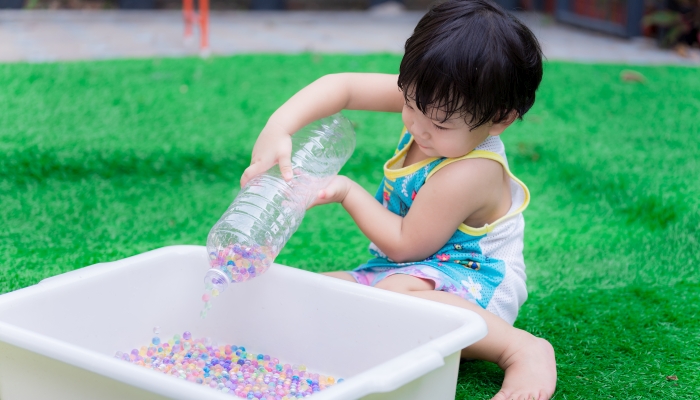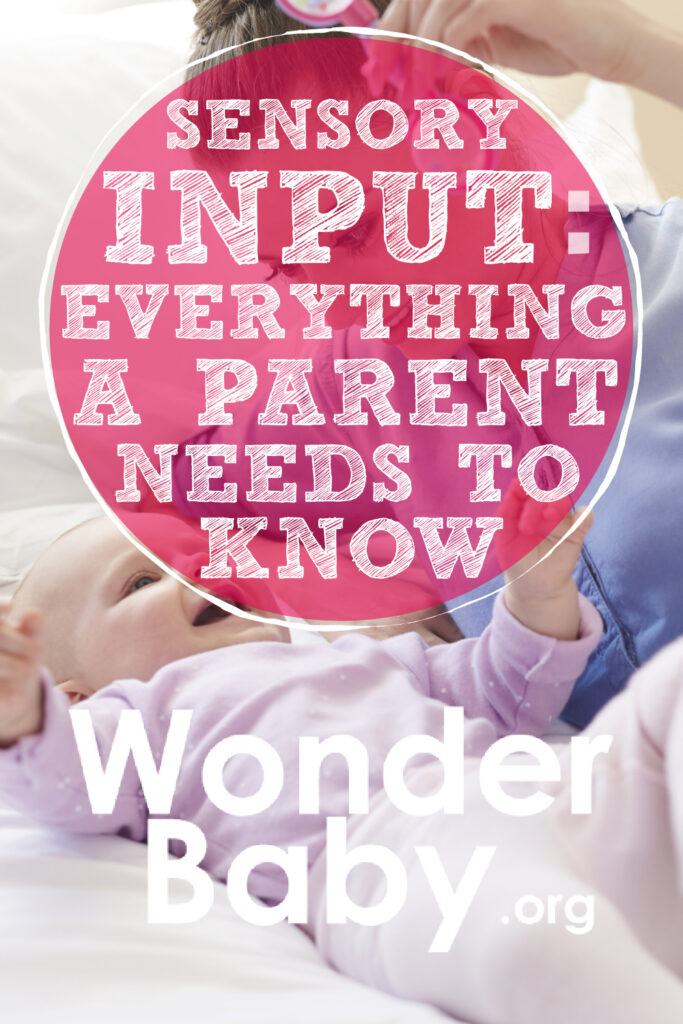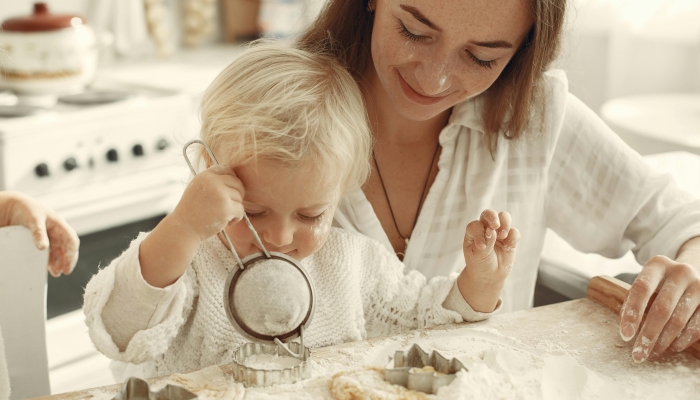Sensory Input: Everything a Parent Needs to Know

- Sensory input is the information our brains get from our senses.
- There are seven types of sensory input: taste, smell, hearing, sight, touch, body movement, and body awareness.
- Sensory input helps with problem-solving skills, language skills, motor skills, and even social skills.
- Some children seek more sensory input, while others avoid it.
- There are many activities you can do with your child to help them with sensory processing.
Picture this—your kids have turned on every toy that makes noise, and they’re screaming at the top of their lungs.
You hear the background sounds of your husband’s TV show as he turns up the volume to compete with the kids.
You’re trying to cook dinner, and the smell of burning reminds you that something needs to come out of the oven.
You find yourself taking deep breaths and closing your eyes just to tune out the world for a moment.
If this sounds familiar, there’s a good chance that you’ve experienced sensory overload. The majority of adults and children have experienced it at one time or another. Children are especially sensitive to sensory input because their brains are still developing.
What Is Sensory Input?
In order to fully understand sensory overload, it is necessary to first understand sensory input. You probably know that we have five senses: taste, smell, touch, sight, and hearing. We use those senses to make sense (no pun intended) of the world around us.
Our bodies use our sensory organs (our mouths, noses, skin, ears, and eyes) to send information to our brains. That sensory information is called sensory input. Our brains then respond to that sensory input by letting us know if we like or dislike it.
For example, when I hear people chewing loudly, it makes my skin crawl. My auditory system has sent information to my brain about this sound, and my brain has responded that I strongly dislike it.
On the other hand, there are many types of sensory stimuli my brain has decided I enjoy, like the smell of lavender. When I’m feeling overwhelmed and I smell lavender, that sensory input is sent from my nose to my brain, and I feel calmer.
What Are the Different Types of Sensory Input?
Despite what you’ve already learned, there is one caveat when it comes to sensory input. Humans actually have seven senses, not five.
The other two senses are body movement and body awareness. Check out the descriptions of all seven of our senses below:
| Sense | Description |
| Taste/Gustatory |
|
| Touch/Tactile |
|
| Hearing/Auditory |
|
| Sight/Visual |
|
| Smell/Olfactory |
|
| Body Movement/Vestibular |
|
| Body Awareness/Proprioception |
|

How Important Is Sensory Input in Child Development?
Now you know all seven senses and how they send sensory input to our brains, but how important is all this information when it comes to our children? The answer—very important.
As children develop, they receive tons of sensory stimulation. Their brains then take that stimulation and sort it out so they can respond to it.
When it comes to your children’s development, they’ve been receiving sensory inputs and learning to process them since they were born. They started by turning their heads towards the sound of your voice or squinting their eyes on a sunny day.
As children get older, they receive more sensory stimulation, and their brains decide how they should respond to it. Their brains remember those responses so they know how they should react next time.
Every time your child is exposed to different noises, tastes, textures, smells, sights, and even activities on playground equipment, they are taking those sensory experiences and learning from them.
Through this sensory exploration, children develop problem-solving skills, language skills, motor skills, and even social skills. The way they process sensory input helps them adapt to and thrive in the world around them.
How to Tell if a Child Has Challenges With Processing Sensory Inputs
At this point, you may be panicking because your child cries when they hear loud noises or won’t touch the sand at the beach. Every Every child has their own preferences and quirks, and that doesn’t necessarily mean that they have sensory processing issues.
In a 2018 article by Michele Kong, MD and Megan A. Moreno, MD, MSEd, MPH, it’s estimated that one in six children have sensory processing issues, and that percentage is significantly higher in populations of children with special needs.
How can you tell if your child’s reactions to sensory input are typical or if they’re a result of sensory difficulties? If your child has challenges with sensory processing, it may present in a few different ways. Depending on your child’s behaviors, they may be sensory seekers, sensory avoiders, or a combination.
Sensory seekers need more sensory input for their brains to register the information. Therefore, sensory seekers look for more sensory input to give to their bodies. Your child may be a sensory seeker if they:
- Always seem to be moving
- Constantly look around
- Touch everything
- Have an unusually high pain tolerance
- Crash into walls, furniture, or people
- Put everything into their mouths
- Appear clumsy
- Don’t notice when something they touch is too hot
- Enjoy extremely spicy or sour foods at a young age
- Love to pull or carry heavy items
- Like to spin
- Love to make loud noises
- Have no concept of personal space
- Don’t know their own strength
- Enjoy rough play with others
Sensory avoiders are hypersensitive to sensory input. This means they feel it more intensely than others. These children will avoid types of input because they feel overwhelmed. Your child may be a sensory avoider if they:
- Don’t like touching messy textures
- Are bothered by certain clothes
- Prefer dim lights over bright
- Cover their ears in loud environments
- Avoid playground equipment
- Get anxious when climbing or when feet are off the ground
- Gag or vomit when tasting certain textures
- Eat an extremely limited diet
- Prefer to play with quiet or calm children
- Have meltdowns in busy environments
- Scream when washing their hair or face
- Won’t let you brush their teeth
- Don’t like to walk barefoot
- Gag when smelling certain odors
- Push you away when you try to hug them
It’s possible for a child to exhibit sensory-seeking behaviors and sensory-avoiding behaviors. Every child has their own sensory processing differences.
In general, children with sensory challenges tend to have poor body awareness, speech delays, poor motor skills, difficulty with transitions, immature social skills, and difficulty calming or self-regulating.
When do sensory processing challenges become a disorder?
I can’t stand sudden, loud noises. When my husband sneezes, I feel like I have a heart attack. Do I have a sensory processing disorder? To answer that, I need to ask, “Is my daily life affected by my aversion to startling noises?” No, it isn’t. It’s a sensory challenge for me, but it’s not a disorder.
Your child’s sensory difficulties may qualify as a disorder when they negatively interfere with their (and your family’s) daily lives.
If your child’s issues with certain sensory inputs affect your household routine or how they function in the classroom, they may have a sensory processing disorder.

20 Activities to Boost Your Child’s Sensory Input Processing Skills
If you think your child has sensory challenges or sensory processing disorder, don’t fear! There are activities you can do at home to help them:
Babies
- Use different scented baby lotions and washes.
- Play with rattles.
- Sing to baby.
- Do tummy time on different surfaces.
- Play with mirrors.
- Wrap baby in different towels and blankets to feel various textures.
- Gently swing baby.
Toddlers
- Have them wash their toys in soapy water.
- Put ice cubes in a ziploc bag and have them squeeze and slide the ice around.
- Fill empty bottles or containers with rice to make shaker toys.
- Cook different types of pasta, and put it all in a bin and have your child explore it with their hands.
- Make waterfalls in the tub using different containers and scoops.
- Make your own sugar search game.
- Make a sensory bin by putting objects from nature, foods like rice and beans, or other textured objects like cotton balls into a bin. Add in spoons to scoop and let your child explore.
Preschoolers
- Do a blind taste test by having your child close their eyes or blindfolding them and giving them tastes of fruits they enjoy. Have them guess what it is.
- Set up an obstacle course so your child can climb and jump over cushions, chairs, stuffed animals, etc.
- Make a balance beam with blue tape on the floor and have your child carefully walk on the line.
- Make a sensory bottle.
- Have your child swing on their belly or by twisting the swing in one direction and letting them spin in the other.
- Put a secret object in a bag or box and let your child feel it without seeing it to guess what it is.

Related Posts

Sensory Activities
5 Sand Play Activities to Encourage Fine Motor Development
Sensory bin, at the beach, or in a sandpit? Try these sand play activities to help toddlers and preschoolers develop their fine motor skills.

Sensory Activities
5 Edible Sensory Play Ideas
Check out our favorite edible sensory play activities to engage children's senses, boost their development, and provide hours of fun.

Sensory Activities
How to Make Unpoppable Bubbles
Discover the secret to making unpoppable bubbles with this easy guide. You only need three ingredients!